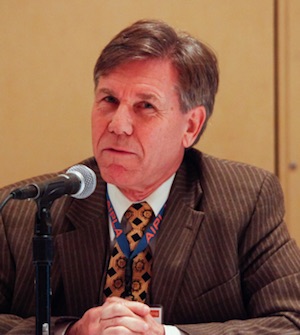
Chief Judge Randall Rader (CAFC, ret.) at the AIPLA annual meeting in 2014.
The American tech consuming public will start to hear the name LeEco much more by the end of October. On October 19th in San Francisco, the China-based conglomerate tech firm will have a launch event which will introduce the brand and its various tech products to the U.S. In its home country, LeEco recently released a smartphone known as the Le Pro 3 and it sold all of the 500,000 units it produced within three minutes. The company has also reportedly raised more than $1 billion USD to develop an electric sports car which the company hopes will rival vehicles produced by Tesla Motors (NASDAQ:TSLA).
In late September, reports from IP management publication IAM indicated that LeEco had signed a strategic cooperative agreement with Randall Rader, former chief judge of the U.S. Court of Appeals for the Federal Circuit (Fed. Cir.). Rader stepped down from his post in May 2014; remarks published by IAM that June indicated that Rader was looking to pursue his passion for teaching others around the world about intellectual property rights. Although the scope of Rader’s role with LeEco remains to be seen, the fact that the Chinese electronics company went so far as to retain a former Federal Circuit judge with a great knowledge of American IP law strongly suggests that LeEco is very interested in protecting its patent rights in the U.S. market.
This isn’t the only personnel decision at LeEco in recent months which points to the company making a major push in North America. Around the same time as the Rader agreement, LeEco announced that it had hired Richard Ren as its acting president of North America operations. Ren had previously worked with Chinese telecom provider Huawei (SHE:002502), where he served in executive positions for the past 12 years. A few days after that announcement, LeEco released the news that it had appointed Rob Chandhok, a former division president at Qualcomm (NASDAQ:QCOM), as LeEco’s chief research and development officer for North America.
Corporate acquisitions completed by LeEco this year also support the notion that the company is planning to make a large footprint in the U.S. In mid-September, LeEco announced that it had acquired filmmaking firm Dichotomy Creative Group. LeEco will retain the CEO and staff of Dichotomy and is putting the firm in charge of creating English-language original entertainment content for LeEco. This April, LeEco unveiled an 80,000-square-foot facility in San Jose which will serve as the company’s North American headquarters where as many as 800 employees will work on autonomous driving research and other consumer tech areas. In July, LeEco completed an agreement to purchase American-based television developer Vizio for $2 billion; reports indicate that Vizio will continue to operate as a private subsidiary. Also, in June, the Silicon Valley Business Journal reported that LeEco paid $250 million to acquire a 48.6-acre development site from American tech company Yahoo! Inc. (NASDAQ:YHOO). LeEco is approved to build 3-million-square-feet of space for up to 12,000 workers at the Santa Clara, CA-area site.

![[IPWatchdog Logo]](https://ipwatchdog.com/wp-content/themes/IPWatchdog%20-%202023/assets/images/temp/logo-small@2x.png)

![[[Advertisement]]](https://ipwatchdog.com/wp-content/uploads/2024/04/Patent-Litigation-Masters-2024-banner-early-bird-ends-Apr-21-last-chance-938x313-1.jpeg)
![[Advertisement]](https://ipwatchdog.com/wp-content/uploads/2024/04/Patent-Litigation-Masters-2024-sidebar-early-bird-ends-Apr-21-last-chance-700x500-1.jpg)

![[Advertisement]](https://ipwatchdog.com/wp-content/uploads/2021/12/WEBINAR-336-x-280-px.png)
![[Advertisement]](https://ipwatchdog.com/wp-content/uploads/2021/12/2021-Patent-Practice-on-Demand-recorded-Feb-2021-336-x-280.jpg)
![[Advertisement]](https://ipwatchdog.com/wp-content/uploads/2021/12/Ad-4-The-Invent-Patent-System™.png)







Join the Discussion
One comment so far.
Paul F. Morgan
October 10, 2016 04:11 pmJudge Rader’s new LeEco client counseling position will likely include defending the entry of various new Chinese products into U.S. markets. For which, ironically, he is highly likely to now have to advise on the use of the IPRs he famously called “death squads.”